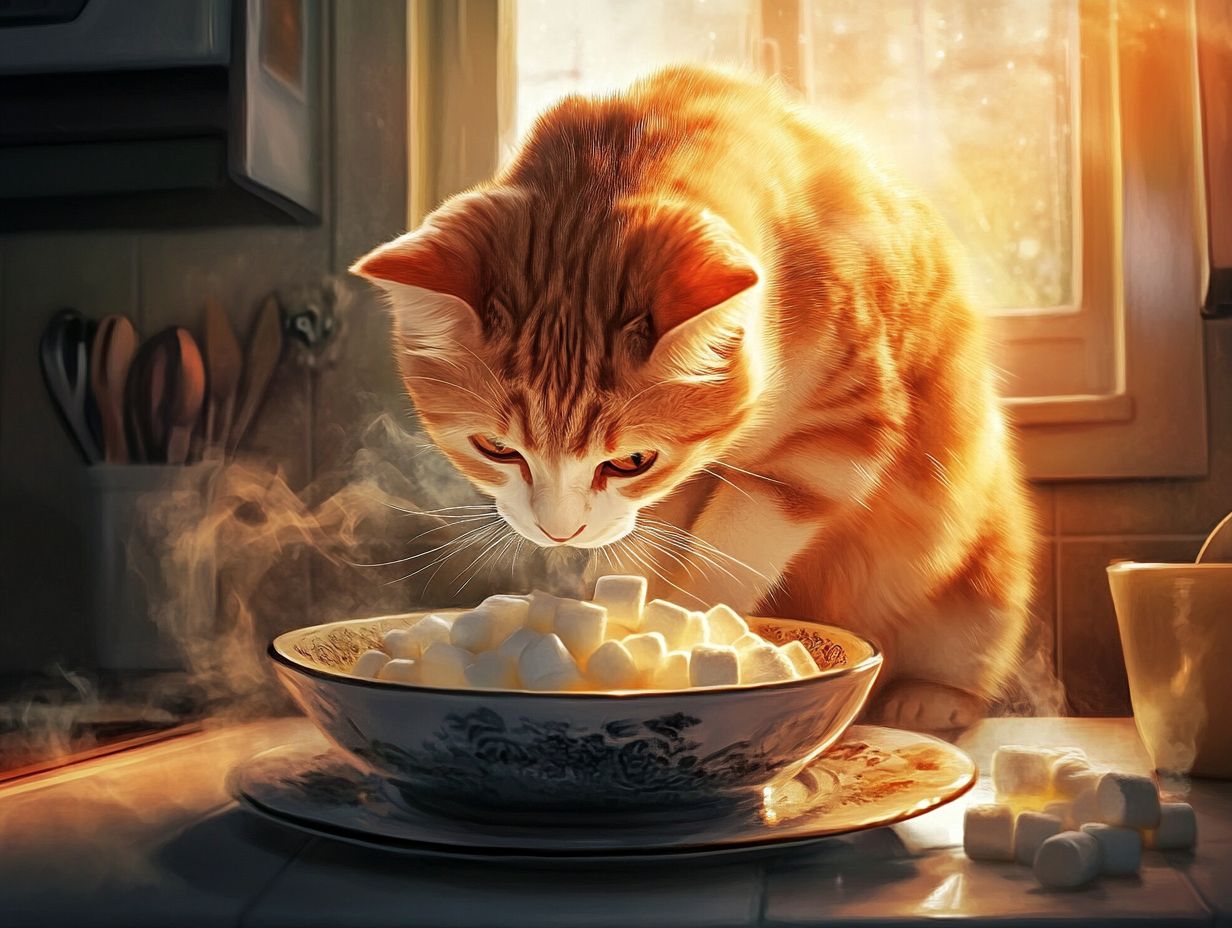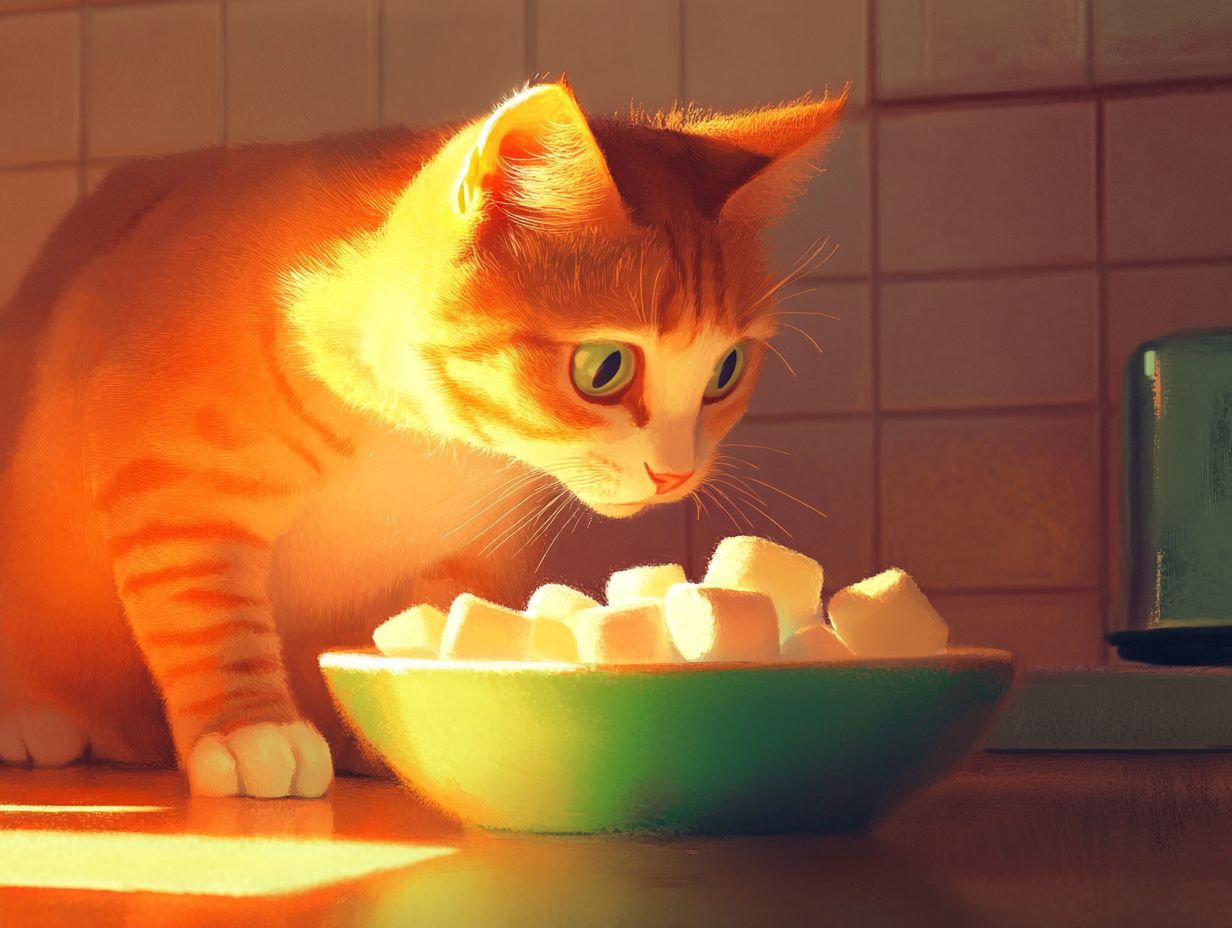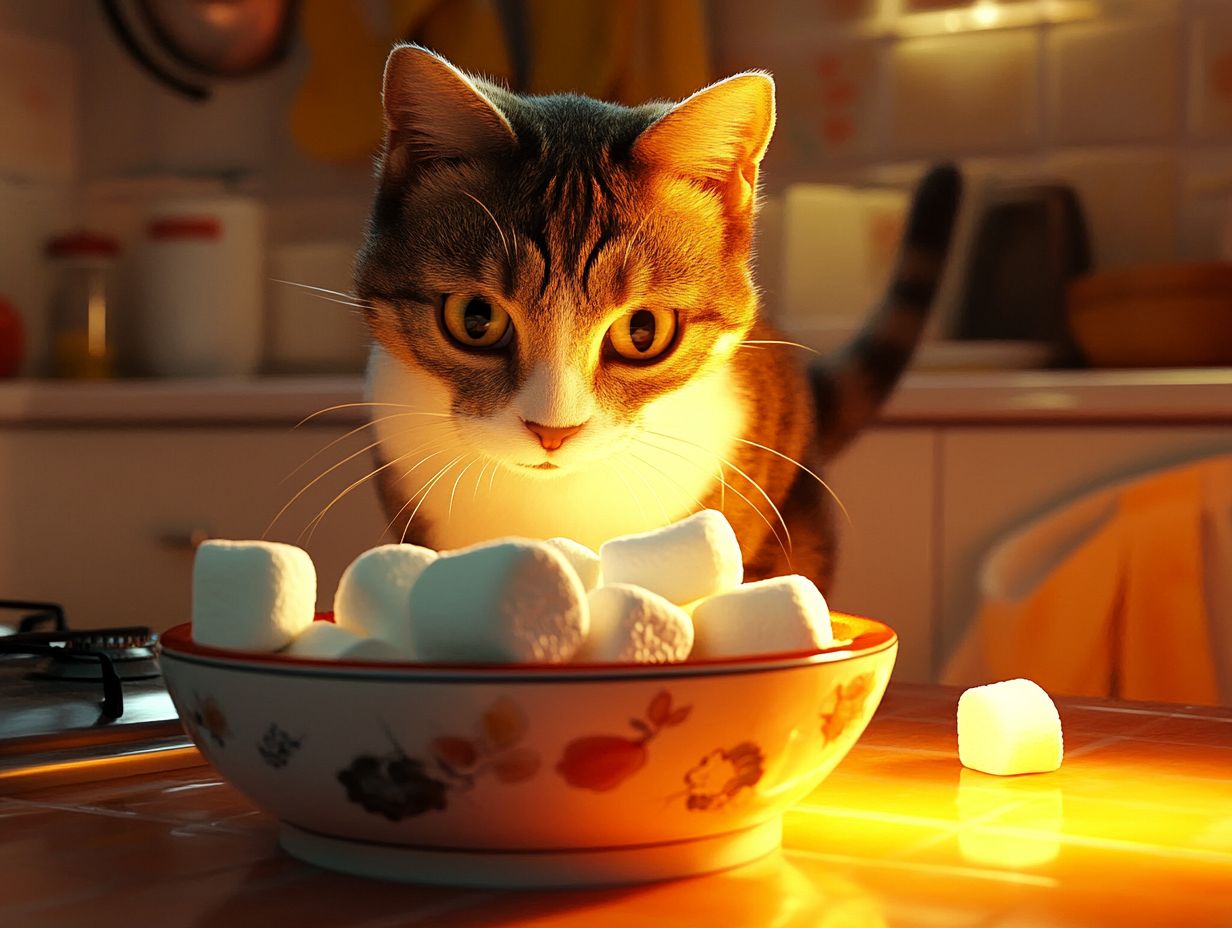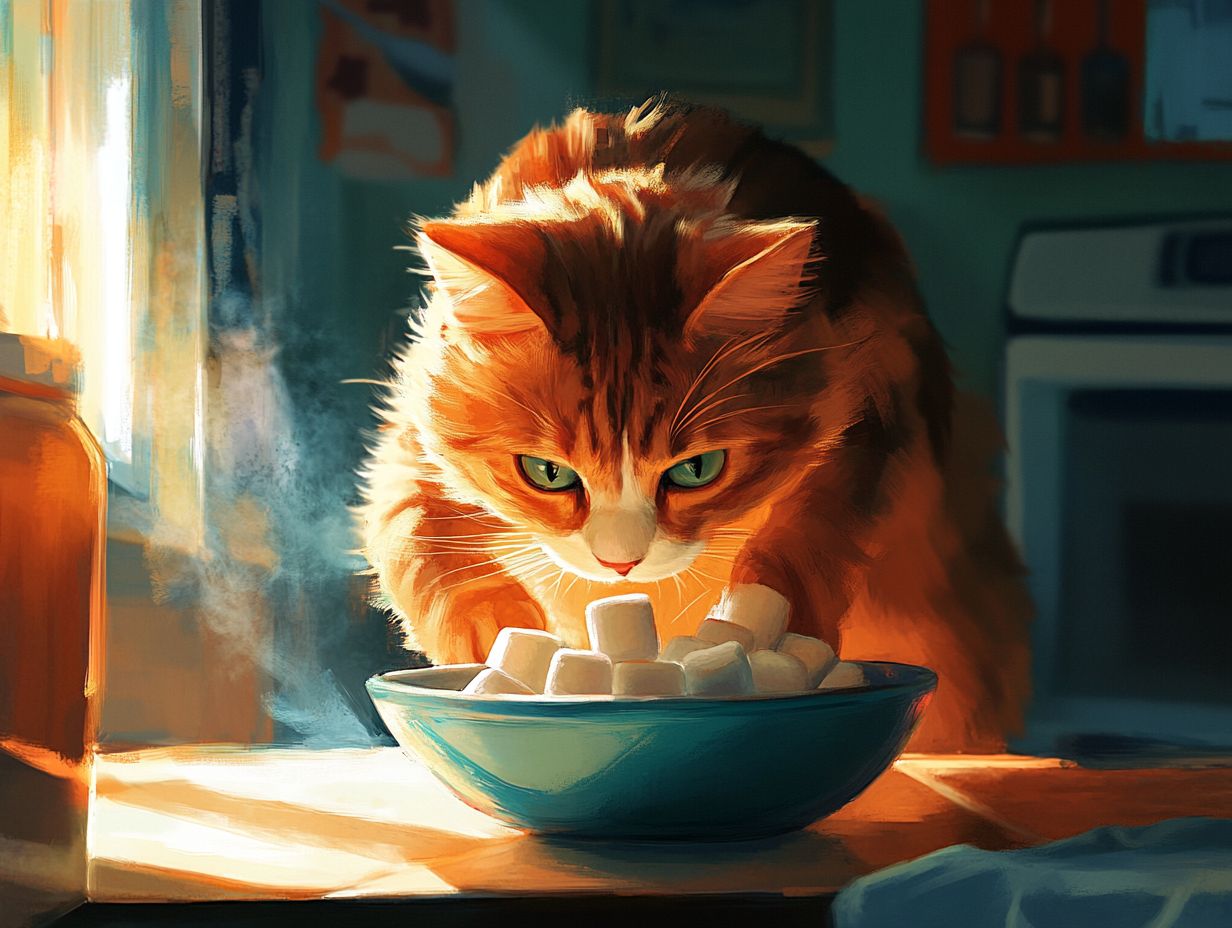Curious whether your feline friend can indulge in marshmallows or marshmallow fluff? While these sugary snacks may seem harmless, marshmallows should not be fed to cats. Understanding a cat’s dietary needs and the potential risks associated with feeding them sugary snacks is crucial. These risks can include sugar rush effects and the sticky texture of marshmallows.
This article explores the ingredients to avoid, health concerns linked to marshmallows, and safe alternatives—such as catnip and special treats—that can satisfy your cat’s cravings without compromising their well-being. Let’s dive in!
Key Takeaways:

- Cats have specific dietary needs and should not consume human foods, including marshmallows and sweets, without consulting a veterinarian.
- Certain ingredients in marshmallows can be toxic to cats and should be avoided at all costs.
- It is important to offer cats safe and healthy treat alternatives, such as freeze-dried meat or catnip, rather than sugary snacks like marshmallows, which might lead to obesity and other health issues.
- Limit treats to no more than 10% of your cat’s daily caloric intake to maintain a balanced diet.
Can Cats Eat Marshmallows?
Cats are meat-eating animals that must consume protein to stay healthy. Many pet owners wonder if it is safe to give their cats human food, such as marshmallows.
While these sugary snacks may seem harmless, it’s important to understand the implications of feeding marshmallows to cats and whether they pose any health risks. Marshmallows primarily consist of sugar and gelatin. But can cats consume them without negative health consequences?
This article will explore the nutritional requirements of cats, assess the safety of marshmallows, and suggest alternatives that may be better suited for your pet.
Understanding a Cat’s Diet
Understanding a cat’s diet is crucial for their health and well-being. Cats have specific dietary needs that differ from those of other pets, such as dogs. They are primarily meat-eaters, meaning their diet must consist mainly of protein from animal sources. While some cats may enjoy vegetables and fruits as occasional snacks, their primary nutrition should come from meat. A balanced diet supports a cat’s energy requirements, hydration, and digestion, and prevents obesity. It’s also essential to avoid harmful foods such as chocolate and grapes.
Consulting a veterinarian can help pet owners grasp this crucial aspect of cat care. In addition to adequate protein, ensuring hydration is vital, as cats often do not drink enough water on their own. Incorporating wet food can help increase moisture intake and support kidney function. Safe snacks, like small pieces of cooked chicken (1-2 tablespoons), can add variety without compromising their health. For more information on treats, check out Can Cats Eat Marshmallows? Sweet Treat or Hazard?.
Veterinarians can provide specific dietary recommendations based on a cat’s age, activity level, and any particular health concerns, ensuring that all nutritional needs are met. By prioritizing these components, pet owners can help ensure that their cats lead happy, healthy lives.
Potential Risks of Feeding Marshmallows to Cats
Feeding marshmallows to cats can be potentially dangerous to their health, as these sugary treats can negatively affect a cat’s well-being in several ways. Marshmallows are high in sugar and contain other potentially harmful additives, such as artificial food coloring and sodium, that are not part of a cat’s essential diet.
While a small bite may not cause immediate harm, long-term exposure can lead to obesity and various gastrointestinal issues, often manifesting in cats as vomiting or diarrhea. Additionally, certain ingredients in marshmallows can be toxic to cats, making it essential to approach this treat with caution.
Ingredients to Avoid

When considering treats for your cat, it is vital to avoid ingredients such as xylitol, chocolate, and other harmful additives. Always check ingredient labels and consult with your veterinarian before introducing any new treats.
Conclusion
In summary, marshmallows are unsuitable for cats due to their high sugar content and potentially harmful ingredients. It is crucial to prioritize your cat’s health by consulting a veterinarian for dietary advice and offering safe alternatives like small portions of cooked chicken or fish. By doing so, you can help ensure a happy and healthy life for your feline friend.
As a cat owner, it’s essential to be aware of potentially harmful ingredients when selecting snacks for our feline friends. Many commercially available treats, including marshmallows, can contain dangerous additives such as artificial food coloring, high sugar content, and toxic ingredients like chocolate and sodium. These ingredients can cause serious health problems in cats, including digestive issues and long-term health complications. Therefore, it is vital for pet owners to examine labels carefully and choose cat-safe snacks that do not contain these harmful ingredients.
Healthy alternatives, such as freeze-dried meats or specially formulated cat treats that prioritize nutrition over taste, can effectively replace sugary snacks that contribute to obesity and diabetes. Common ingredients in marshmallows can pose risks, especially if gelatin is sourced from unsafe origins. Ideally, cat snacks should consist of natural ingredients and contain no artificial preservatives or flavors. By selecting quality products specifically designed for cats, owners can offer tasty treats without compromising their pets’ health.
Health Risks of Marshmallows
When considering whether to give cats marshmallows or other new treats, it’s essential to take their health concerns and allergies into account. Many cats may have adverse reactions to certain ingredients, leading to symptoms such as vomiting, diarrhea, or lethargy. Obesity is another serious concern, especially if sugary treats are offered frequently; being overweight can exacerbate other health issues. Consulting with a veterinarian can help identify any specific allergies a cat may have and guide pet owners toward healthier alternatives that won’t negatively impact their cat’s health.
Allergies can manifest in various ways; some cats may display signs like skin irritations, excessive scratching, or even ear infections. Common allergens found in treats include artificial flavors, dairy, and certain proteins, making it crucial to read labels carefully. Additionally, behavioral changes, such as increased aggression or withdrawal, might indicate that a cat is experiencing discomfort from inappropriate snacks. Therefore, it is important for cat owners to remain vigilant and proactive in monitoring their pets’ reactions.
A veterinarian’s expertise can be invaluable in navigating these dietary challenges, ensuring a happier and healthier feline companion.
Benefits of Natural Treats
The best alternatives to marshmallows for cats include treats that are free of sugar yet still offer joy and satisfaction. Catnip is a popular choice that many cats enjoy. Additionally, certain safe vegetables and fruits, such as pumpkin or fish, can serve as snacks for felines. For example, offer no more than a tablespoon of pumpkin puree per day to ensure health benefits without overconsumption.
These alternatives can effectively replace marshmallows in a cat’s diet while keeping them engaged. Moreover, substituting marshmallows with these options can enhance a cat’s hydration and provide a healthier alternative to sugary snacks.
How to Safely Introduce New Treats
When selecting safe and healthy treat options for cats, numerous natural alternatives can meet their needs. Sliced cooked fish, catnip snacks, and certain fruits and vegetables offer various benefits, including satisfying instinctual behaviors and providing nutritional value when given in moderation. For instance, small amounts of cooked chicken or pumpkin are excellent choices, contributing protein and fiber that promote digestive health. Including essential oils that are cat-friendly can also be beneficial. These foods should only be provided as occasional extras within a balanced diet.
By managing the frequency of these treats, caregivers can ensure they enhance their cats’ diets without promoting overconsumption and the risk of obesity. Look for brands that offer freeze-dried chicken or fish specifically formulated for cats, as these products are often both safe and enjoyable for your pets.
Summary
Always prioritize your cat’s health by choosing safe treats and consulting your veterinarian for personalized advice. By being mindful of the ingredients and opting for natural alternatives, you can ensure your feline companion enjoys treats that contribute to their overall well-being.

The safest way to introduce treats to cats is to do so cautiously and in a controlled manner. This process involves selecting appropriate treats, offering them gradually, monitoring for any adverse reactions, controlling the frequency of treat offerings, and consulting a veterinarian about the cat’s specific needs and potential symptoms of allergies or poisoning.
- Select Appropriate Treats: Treats should be chosen based on any health conditions your cat may have. Suitable options may include small pieces of cooked chicken, blueberries, or commercially manufactured cat treats that are safe for felines.
- Gradual Introduction: New foods should be introduced gradually, meaning that only small portions of any new treat should be given at a time. Cats can be picky eaters, so owners should observe their cat’s reactions and note any changes in eating habits or gastrointestinal distress, such as vomiting or diarrhea. If a cat shows any signs of dislike towards a treat, it should be removed from their diet immediately.
- Portion Control: Treats should be offered in small portions to avoid overfeeding. A treat is defined as any food that is not part of the cat’s regular diet. Ideally, the main diet should constitute 90-95% of a cat’s food intake, while treats should make up only 5-10%. For example, a small cat might benefit from 1-2 small treats per day, while larger cats can have 2-3.
- Frequency Control: Treats should be given infrequently to ensure they do not replace the cat’s regular food and to prevent obesity. While this guideline is suitable for most cats, the appropriate percentage of calories derived from treats may vary based on individual circumstances, including age, weight, and health conditions. Consulting a veterinarian for guidance on these factors is advisable.
- Consult a Veterinarian: If there are any changes in a cat’s behavior or preferences regarding their regular food, a veterinarian should be consulted to rule out potential health issues. Additionally, a veterinarian can provide guidance on the safest types of treats to offer based on the cat’s individual dietary needs and health conditions.
Proper Portion Sizes and Frequency
Understanding proper portion sizes and the frequency of giving treats is essential for maintaining a healthy diet for cats, especially when introducing new options like snacks or treats. Overfeeding can lead to obesity and other health concerns, making it important to adhere to guidelines regarding how much and how often to offer treats.
Ideally, treats should constitute only a small percentage of a cat’s overall diet, ensuring that their primary nutrition comes from high-quality cat food that meets their dietary needs. For optimal health, it is generally recommended that treats make up no more than 10% of a cat’s daily caloric intake.
The specific weight and lifestyle of each cat should guide the number of treats given. An active cat may require a different allowance compared to a sedentary one. Monitoring the frequency and type of treats is crucial, as some may contain high levels of calories, sugars, or fats that can contribute to weight gain.
By ensuring that the main diet remains balanced, owners can help prevent health issues such as feline obesity, diabetes, and joint problems, thus safeguarding their pets’ overall well-being.

Frequently Asked Questions
Can Cats Eat Marshmallows?
It is generally not recommended to feed cats marshmallows, as they have limited nutritional value for felines and can potentially cause health problems.
Why is it not recommended for cats to eat marshmallows?

Marshmallows contain high amounts of sugar and carbohydrates, which can cause weight gain and potential issues with diabetes in cats.
Are there any potential hazards for cats if they eat marshmallows?
Yes, the high sugar content in marshmallows can lead to gastrointestinal upset, such as vomiting and diarrhea, in cats. In some cases, it may also cause a blockage in their digestive system.
Can cats have any negative reactions to eating marshmallows?
Some cats may have allergic reactions to certain ingredients in marshmallows, such as the artificial dyes and flavors. These can manifest as skin irritation, itching, and even respiratory issues.
Are there any benefits to giving cats marshmallows?
No, there are no nutritional benefits for cats to consume marshmallows. Cats are obligate carnivores and require meat-based diets, so marshmallows do not provide any essential nutrients for them.
What are some safe and healthy treats to give cats instead of marshmallows?
Consider offering freeze-dried meat treats or commercial cat treats specifically formulated for feline diets as healthier alternatives.
What human foods are safe for cats?
Safe human foods for cats include cooked meats, plain rice, and certain vegetables like carrots and peas in moderation.
How can I tell if a treat is healthy?
Look for treats made with natural ingredients, low in calories, sugars, and fats, and specifically formulated for feline health.
Conclusion
Moderation in treats is crucial for your cat’s health. Always prioritize their primary nutrition from balanced cat food and consult with a veterinarian for the best dietary practices.
Guidelines for Safe Feeding
Cats can enjoy small portions of healthy cat treats like cooked, unseasoned meat or certain types of fish as occasional delights. Safe options include chicken, turkey, and salmon, prepared without bones. Limit treats to no more than 10% of your cat’s daily caloric intake to maintain a balanced diet.
Benefits of Treats
Cooked meat provides high-quality protein, while canned pumpkin can aid digestion due to its fiber content. These healthy cat treats can enhance your cat’s overall diet.
Risks of Certain Foods
While some fish can be a good treat, be cautious with types like tuna, which can be harmful in large amounts due to mercury content. Additionally, dairy products such as yogurt may not be suitable for all cats, especially those with lactose intolerance.
Before introducing any new treat, discuss it with your veterinarian to ensure it’s appropriate for your cat’s health needs. By choosing safe and healthy treats, you can enhance your cat’s diet while keeping their health in check.